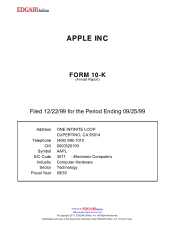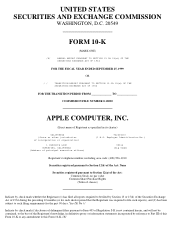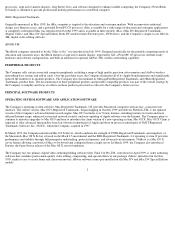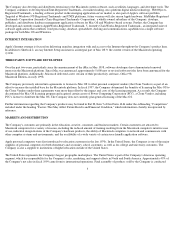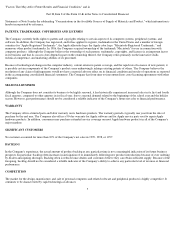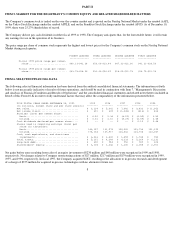Apple 1999 Annual Report Download - page 5
Download and view the complete annual report
Please find page 5 of the 1999 Apple annual report below. You can navigate through the pages in the report by either clicking on the pages listed below, or by using the keyword search tool below to find specific information within the annual report.processors, large active-matrix displays, long battery lives, and software designed to enhance mobile computing, the Company's PowerBook
G3 family is intended to provide professional desktop performance in a notebook computer.
iMAC-Registered Trademark-
Originally announced in May 1998, the iMac computer is targeted at the education and consumer markets. With an innovative industrial
design, easy Internet access, and a powerful PowerPC G3 processor, iMac is suitable for a wide range of education and consumer applications.
A completely redesigned iMac was introduced in October 1999 and is available in three models: iMac, iMac DV-Registered Trademark-
(Digital Video), and iMac DV Special Edition. Both DV models feature Firewire ports, DVD drives, and the Company's simple-to-use iMovie-
TM- digital video editing software.
iBOOK-TM-
The iBook computer, intended to be the "iMac to Go," was introduced in July 1999. Designed specifically for the portable computing needs of
education and consumer users, the iBook features a large active-matrix display, long battery life, a PowerPC G3 processor, Internet-ready
hardware and software configurations, and built-in antennas for optional AirPort-TM- wireless networking capability.
PERIPHERAL PRODUCTS
The Company sells certain associated computer peripherals, including a range of high quality precision color monitors and AirPort wireless
networking base stations and add-in cards. Over the past three years, the Company eliminated all of its Apple-
branded printers and significantly
reduced the number of its monitor products. The Company also discontinued its MessagePad-Registered Trademark- and eMate-Registered
Trademark- product lines. The discontinuance of these peripheral products and portable computing products was part of the overall strategy by
the Company to simplify and focus its efforts on those products perceived as critical to the Company's future success.
PRINCIPAL SOFTWARE PRODUCTS
OPERATING SYSTEM SOFTWARE AND APPLICATION SOFTWARE
The Company's operating system software, Mac-Registered Trademark- OS, provides Macintosh computers with an easy, consistent user
interface. The current version, Mac OS 9-Registered Trademark-, began shipping in October 1999 and delivers Sherlock-TM- 2, the updated
version of the Company's advanced Internet search engine. Mac OS 9 includes over 50 new features, including features for faster and more
efficient Internet usage, enhanced system and network security, and auto-updating of Apple software over the Internet. The Company plans to
continue to introduce upgrades to Mac OS 9 and later to introduce the client version of a new operating system, Mac OS X. Mac OS X Client is
expected to offer advanced functionality based on software technologies of Apple and those in-process technologies of NeXT-Registered
Trademark- Software, Inc. (NeXT), which the Company acquired in 1997.
In March 1999, the Company introduced Mac OS X Server, which combines the strength of UNIX-Registered Trademark- and simplicity of
the Macintosh. Mac OS X Server is based on the Mach 2.5 microkernel and the BSD-Registered Trademark- 4.4 operating system. It provides
performance and stability through full preemptive multitasking, protected memory, and advanced virtual memory. NetBoot is a Mac OS X
server feature allowing a network of Macs to be booted and configured from a single server. In March 1999, the Company also introduced
Darwin, the Open Source release of the Mac OS X server foundation.
The Company has two primary digital video authoring/editing software titles. Final Cut Pro-TM-, introduced in April 1999, is video authoring
software that combines professional-quality video editing, compositing, and special effects in one package. iMovie, introduced in October
1999, makes it easy to create home and classroom movies. iMovie software comes pre-installed on all iMac DV and iMac DV Special Edition
models.
2

